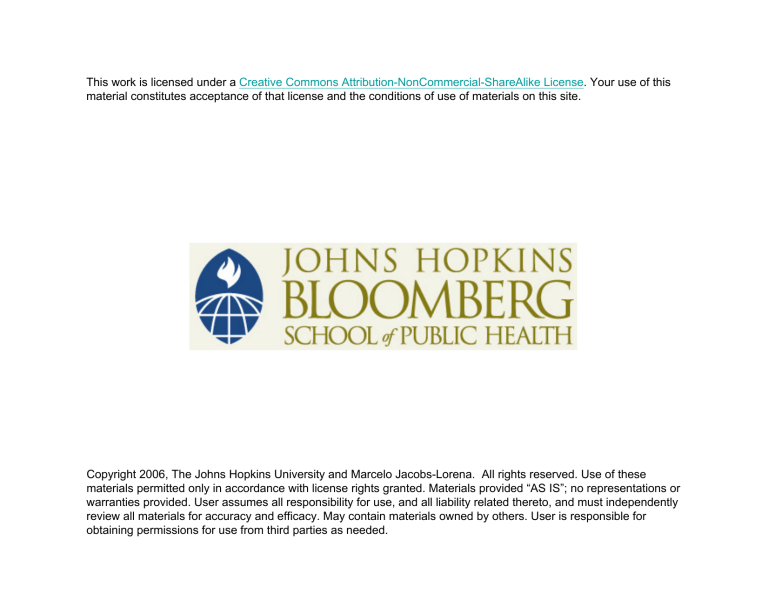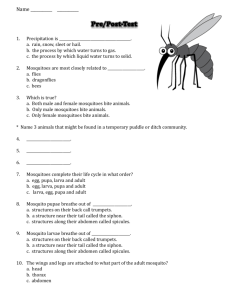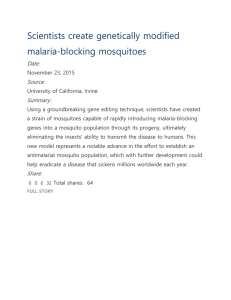licensed under a . Your use of this Creative Commons Attribution-NonCommercial-ShareAlike License

This work is licensed under a Creative Commons Attribution-NonCommercial-ShareAlike License . Your use of this material constitutes acceptance of that license and the conditions of use of materials on this site.
Copyright 2006, The Johns Hopkins University and Marcelo Jacobs-Lorena. All rights reserved. Use of these materials permitted only in accordance with license rights granted. Materials provided “AS IS”; no representations or warranties provided. User assumes all responsibility for use, and all liability related thereto, and must independently review all materials for accuracy and efficacy. May contain materials owned by others. User is responsible for obtaining permissions for use from third parties as needed.
Genetic Approaches for
Malaria Control
Marcelo Jacobs-Lorena, PhD
The Malaria Problem
At risk: >2,000,000,000 in 102 countries
Infected: >270,000,000
Clinically ill: >110,000,000 cases each year
Deaths: >2,000,000 each year
• 90% in Africa
• Mainly children 5-yr-old or younger
From CDC web site
Possible Weapons to Fight Malaria
1. Drugs that kill the parasite in humans
2. Insecticides that kill the mosquito vector
1. Drugs
Plasmodium falciparum is now largely resistant to chloroquine, which used to be the most effective drug.
2. Insecticides: Mosquitoes Quickly
Acquire Resistance
Before During After
Biologic niche intact Mosquitoes return
Mosquito Breeding
Photo: Marcelo Jacobs-Lorena
Mosquito Breeding
Photo: Marcelo Jacobs-Lorena
Mosquito Breeding
Photo: Marcelo Jacobs-Lorena
3. Vaccine …
… does not exist (yet).
It does not exist (yet)…
(transmission by transfusion has no epidemiological significance)
Anopheles gambiae
CDC
1) GENETICALLY ENGINEER MOSQUITOES
TO MAKE THEM RESISTANT TO PLASMODIUM
2) INTRODUCE THE REFRACTORY GENE(S)
INTO MOSQUITO POPULATIONS
LESS TRANSMISSION LESS MALARIA
Plasmodium development in the mosquito
Ghosh et al. (2003) Trends in Parasitology 19 :94-101. Used with Permission.
The use of a
PHAGE DISPLAY LIBRARY to search for peptides with affinity to mosquito salivary gland and midgut epithelia
Salivary gland
Dissect, wash
Injec t
Midgut lumen
Feeder
Elute
Repeat selection 3 times
Dissect gut, open into a sheet, wash
Elute
Repeat selection 3 times
Enriched phage population Enriched phage population
From Ghosh et al. Proc Nat Acad Sci USA 2001;98:13278-1328. Copyright 2001 National Academy of Sciences, USA. Used with permission.
SM1 PEPTIDE
BIOTIN P
A
R
Q
I F
Q
I
S
C C N
SALIVARY GLANDS INCUBATED WITH BIOTINYLATED PEPTIDES pSM1
FITC DAPI unrelated peptide
From Ghosh et al. Proc Nat Acad Sci USA 2001;98:13278-1328. Copyright 2001 National Academy of Sciences, USA. Used with permission.
THE SM1 PEPTIDE BINDS TO THE MIDGUT LUMEN
BUT NOT TO THE OUTSIDE
Open midgut sheet
FITC DIC optics
Closed (intact) midgut
From Ghosh et al. Proc Nat Acad Sci USA 2001;98:13278-1328. Copyright 2001 National Academy of Sciences, USA. Used with permission.
SM1 Construct for Mosquito Germ Line Transformation
Gut-specific & blood-inducible carboxypeptidase promoter
Secretion signal
[SM1]
4
HA1 epitope
An. stephensi
-
piggy
Bac (3xP3-eGFP) eye-specific promoter
Transgenic
WT
Transgenic
Larvae
WT
Adults
Transgenic
Images courtesy of Jacobs-Lorena
in
Inhibition of oocyst formation
CP-[SM1]
4 transgenic mosquitoes
Average of 9 experiments:
Non-trangenic
CP-[SM1]
4
Oocysts/ Inhibition gut
93
82%
18
(range: 69% - 95%)
Ito et al. (2002) Nature 417:452-455.
Challenge: Driving Genes into
Mosquito Populations
What drive mechanisms are being considered?
1. Transposable elements
2. Wolbachia
3. Meiotic drive
An Alternative
Introduce genes into bacteria midgut, instead of into the mosquito itself
Feed E.coli
( , or ) to An. stephensi mosquitoes
After 24 h feed a P. berghei infected blood meal
After 15 d count oocysts per gut (n > 100 mosquitoes)
300
250
200
150
100
50
0
*
*
* p < 0.001
OmpA SM1-1 SM1-2
SM1





